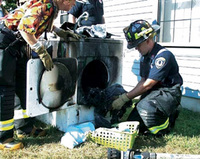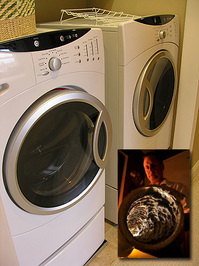Maintain dryers properly to avoid a fire in your laundry room
Dear Keith, I’ve heard stories of the dangers of clothes dryers. Can they truly be dangerous? Sandra M. - Ann Arbor

Photo by Dryerventwizard.com
Fires can occur when heat is built up in the dryer, typically from lack of maintenance. But fear not, a well-maintained dryer and educated homeowner will result in a much safer home and help avoid a place to roast your marshmallows. Dryer usage safety standards are also put in place to protect homeowners. Following are some tips to help you:
Clean the lint screen before and after usage. Also, on a monthly basis, vacuum the lint trap housing cavity to ensure a lint-free environment. Fortunately, your dryer will give you a couple of warning signs that you need to clean the lint traps. For example, clothes may take longer to dry or could be hotter than normal at the end of a drying cycle.
Use the correct dryer vent. White plastic hoses kits are deadly; if you notice this is your dryer vent replace it immediately. A safety standard by Underwriters Laboratories is named UL 2158A “Clothes Dryer Transition Duct” approved high temperature exhaust ducts rated to 430 degrees Fahrenheit. Look for these labeled products. Also shop carefully, venting ducts can often be confused with heating, cooling and bathroom vent fans.
Clean your dryer vent and exhaust duct. Once you have the correct vent and exhaust duct, make sure it’s periodically cleaned properly either by you or a professional. According to Larry Butterfield, the owner of Dryer Vent Wizard located in Canton, the vent should be inspected and cleaned yearly. He continues to explain that not only can lint build up in the vent but other dangers can lurk within. Once he had to remove a muskrat in the dryer vent at a Saline home. Butterfield also recommends rigid aluminum or steel exhaust ducts for better airflow and easy cleaning. Bird nests are also common in the vents and should be removed for the birds' and your safety.

Check your clothes carefully to ensure the absence of volatile chemicals. This includes cleaning products, gasoline, oil, cooking oils and home improvement finishing products. The CPSC suggest washing these clothes more than once to ensure cleanliness and hanging them to dry. The agency also suggests preventing clothes from self igniting after drying by not to leaving them in the dryer or piled in a laundry basket.
Also, ensure the area behind and under the dryer is clean of lint and debris. Obey the length criteria of your vents. The moral of the story is if your dryer vent is working poorly the entire performance of your dryer is poor as well. Enjoy and stay clean.
Paul is a State of Michigan Licensed Builder. Paul serves as President and founding member of HandyPro Handyman Service and nationally franchised HandyPro International. www.handypro.com. Listen to Paul every Saturday at 11:00am on “It’s Your Home, Let’s Talk About It” WAAM Talk 1600AM. Email questions or comments to kpaul@handypro.com.


Comments
BobbyJohn
Fri, Jul 23, 2010 : 11:23 a.m.
That's right, MJS..., Most manufacturers of dryers say not to use the foil vents. Straight aluminum tubing, typically 4" (match to the exhaust vent on the back of the dryer) is preferred, while the flexible, thicker than foil, corrugated aluminum is acceptable. Michigan code only allows a transitional piece of the corrugated aluminum, meaning no more than 8 feet are allowed. Also, remember that the corrugated aluminum must be fully extended; can't use a nonstretched out piece.
MJSteklac
Thu, Jul 22, 2010 : 5:37 p.m.
I changed out our plastic dryer vent tube and found a couple of places where it had melted. Scary, how close we were to a fire. The foil vents aren't much better either.